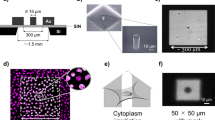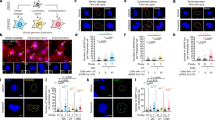Abstract
THE enhanced survival that occurs when mammalian cells are maintained in a density-inhibited state for a short time after treatment with X rays, ultraviolet light or drugs has been termed potentially lethal damage repair (PLDR)1–3. It is analogous to liquid-holding recovery in bacteria and yeast, and has been studied using a variety of agents in different cell lines3–5 and in malignant tumours6,7. To investigate the relationship between this cellular recovery phenomenon and repair at the molecular level, we have examined PLDR in human diploid cell strains with known molecular repair defects. We report here that xeroderma pigmentosum (XP) skin fibroblasts show no PLDR following ultraviolet light irradiation, whereas ataxia telangiectasia (AT) skin fibroblasts are specifically deficient in PLDR following X-ray irradiation. The results suggest that, as in bacterial cells, this cellular recovery phenomenon does reflect molecular DNA repair—probably the excision repair pathway.
This is a preview of subscription content, access via your institution
Access options
Subscribe to this journal
Receive 51 print issues and online access
$199.00 per year
only $3.90 per issue
Buy this article
- Purchase on Springer Link
- Instant access to full article PDF
Prices may be subject to local taxes which are calculated during checkout
Similar content being viewed by others
References
Little, J. B. Nature 224, 804–806 (1969).
Little, J. B. Radiat. Res. 56, 320–333 (1973).
Hahn, G. M. Radiat. Res. 64, 533–545 (1975).
Hahn, G. M. & Little, J. B. Curr. Top. Radiat. Res. Quart. 8, 39–83 (1972).
Weichselbaum, R. R., Nove, J. & Little, J. B. Int. J. Radiat. Biol. 31, 395–299 (1977).
Little, J. B., Hahn, G. M., Frindel, E. & Tubiana, M. Radiology 106, 689–694 (1973).
Piro, A. J., Taylor, C. C. & Belli, J. A. Cancer 37, 2697–2702 (1976).
Cleaver, J. E. in Genetics of Human Cancer (ed. Mulvihill, J. J., Miller, R. W., Fraumeni, J. F., Raven, New York, 1977).
Taylor, A. M. R. et al. Nature 258, 427–429 (1975).
Paterson, M. C., Smith, B. P., Lohman, P. H. M., Anderson, A. K. & Fishman, L. Nature 260, 444–447 (1976).
Lehmann, A. R. et al. Proc. natn. Acad. Sci. U.S.A. 72, 219–223 (1975).
Author information
Authors and Affiliations
Rights and permissions
About this article
Cite this article
WEICHSELBAUM, R., NOVE, J. & LITTLE, J. Deficient recovery from potentially lethal radiation damage in ataxia telangiectasia and xeroderma pigmentosum. Nature 271, 261–262 (1978). https://doi.org/10.1038/271261a0
Received:
Accepted:
Published:
Issue Date:
DOI: https://doi.org/10.1038/271261a0
This article is cited by
-
DNA damage checkpoint control in cells exposed to ionizing radiation
Oncogene (2003)
-
Activation of p53 transcriptional activity requires ATM's kinase domain and multiple N-terminal serine residues of p53
Oncogene (2001)
-
Mammalian Chk2 is a downstream effector of the ATM-dependent DNA damage checkpoint pathway
Oncogene (1999)
-
Cell cycle regulation in response to DNA damage in mammalian cells: A historical perspective
Cancer and Metastasis Reviews (1995)
-
Differential response of human and rodent cell lines to chemical inhibition of the repair of potentially lethal damage
Radiation and Environmental Biophysics (1989)
Comments
By submitting a comment you agree to abide by our Terms and Community Guidelines. If you find something abusive or that does not comply with our terms or guidelines please flag it as inappropriate.



